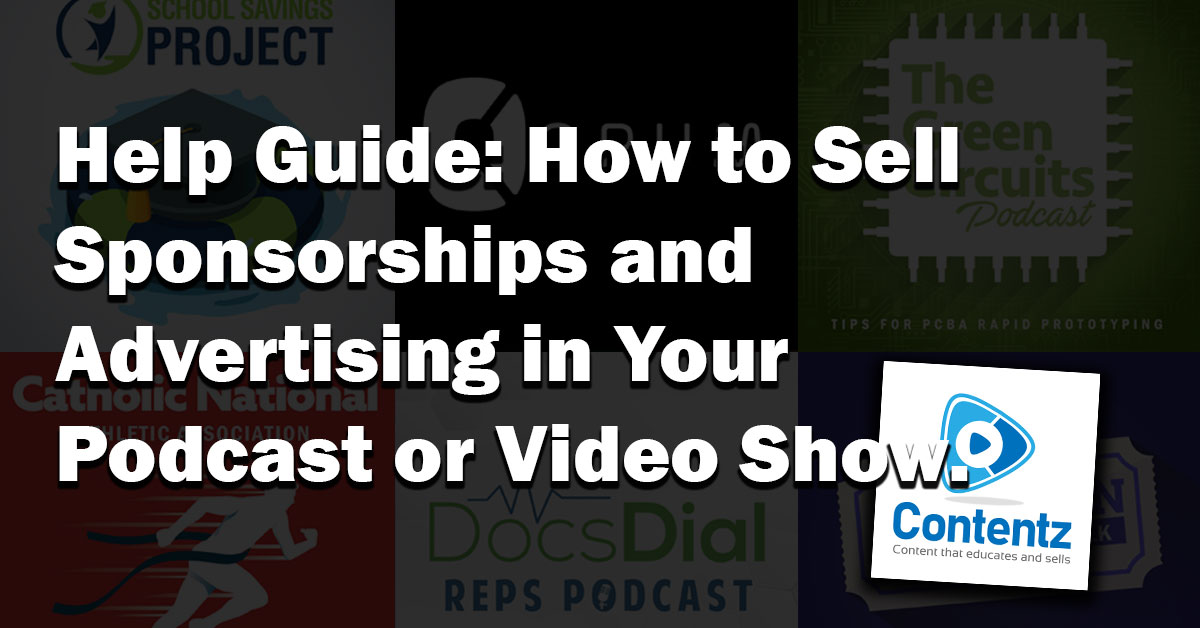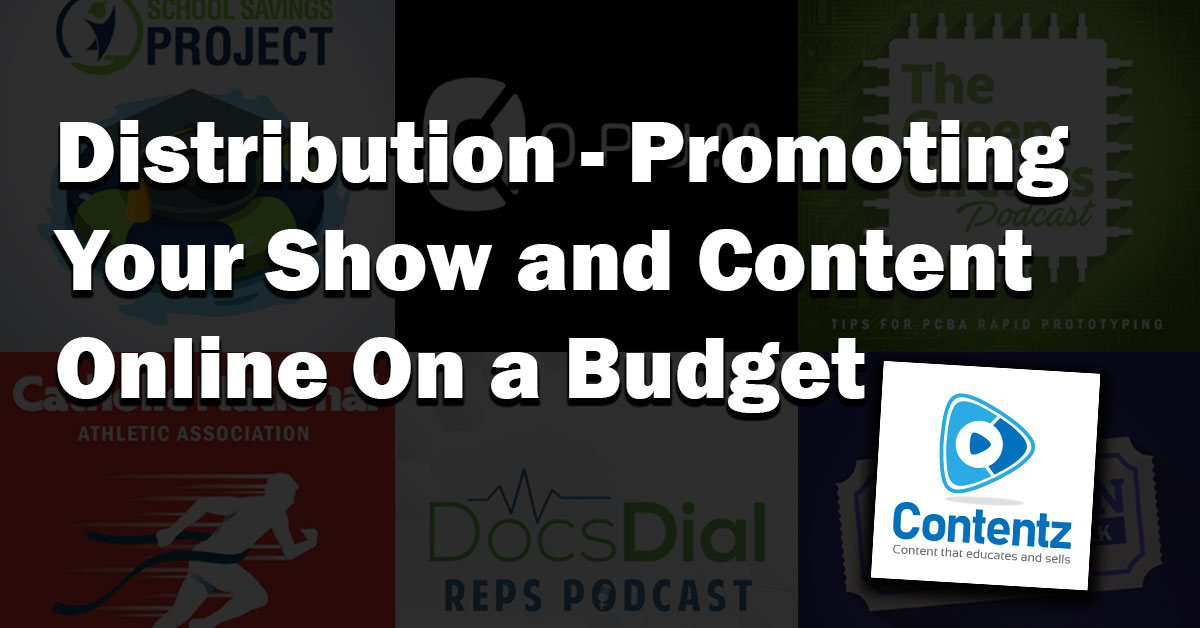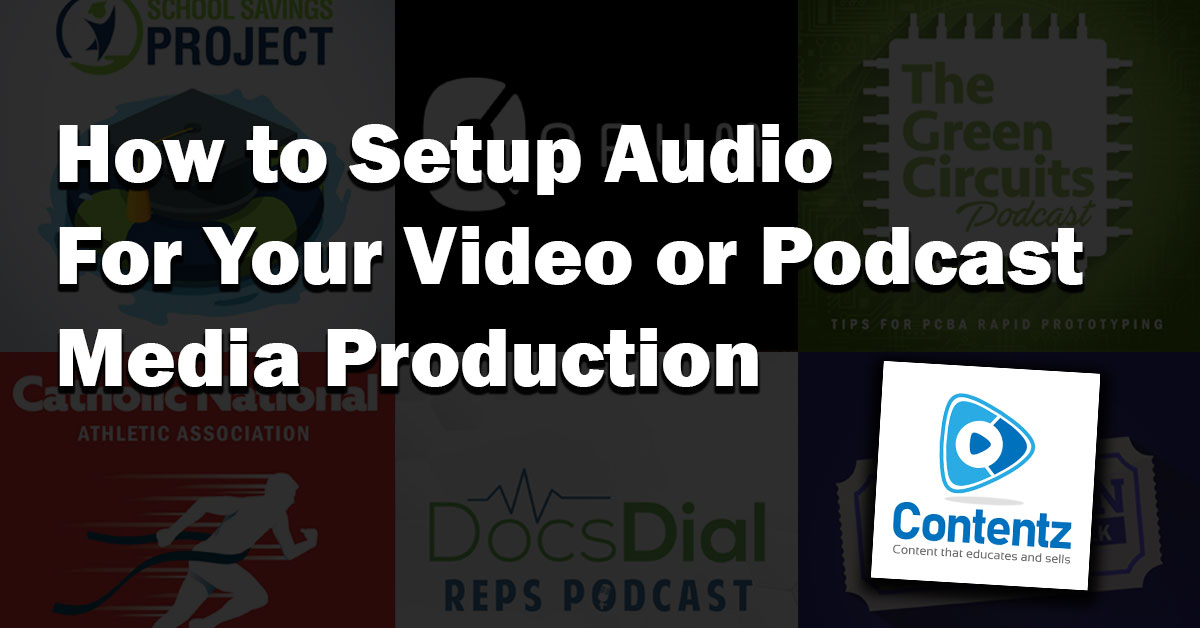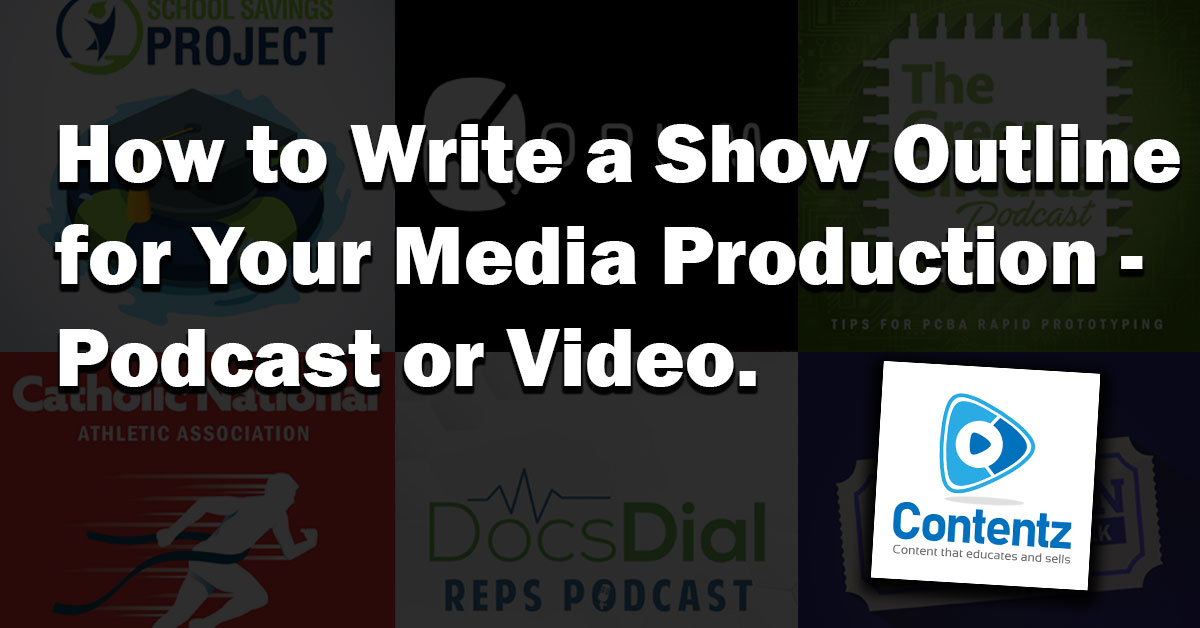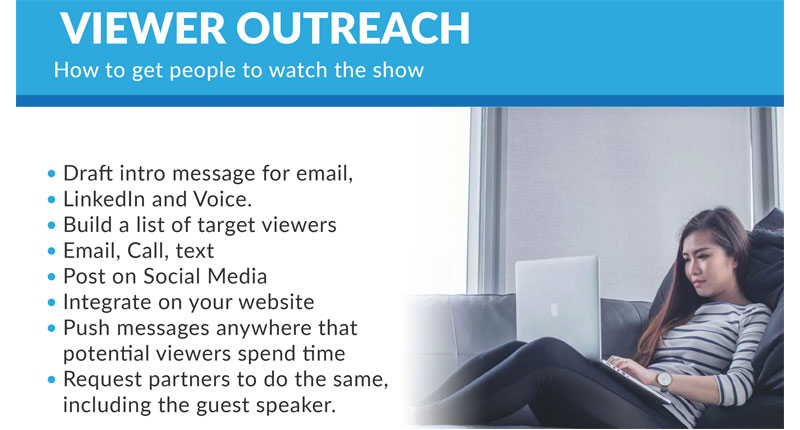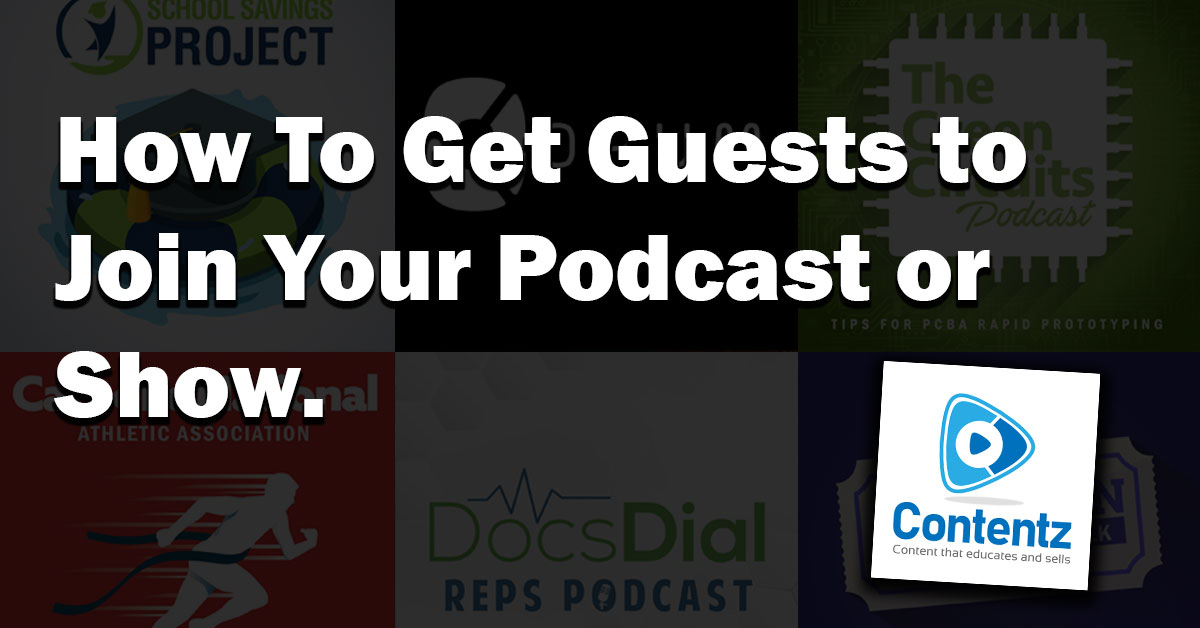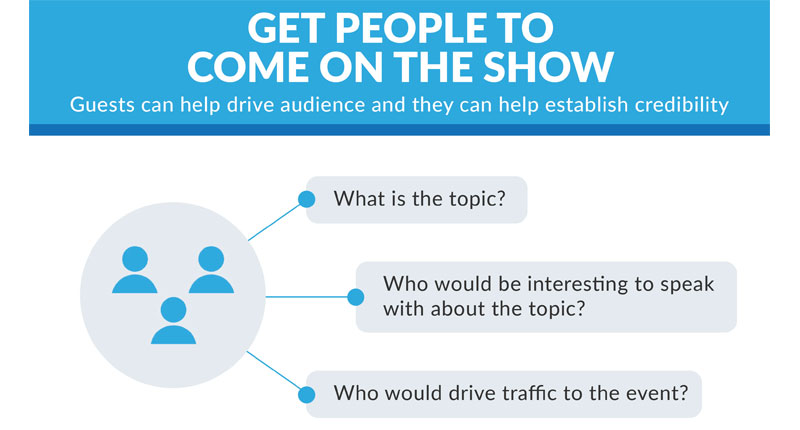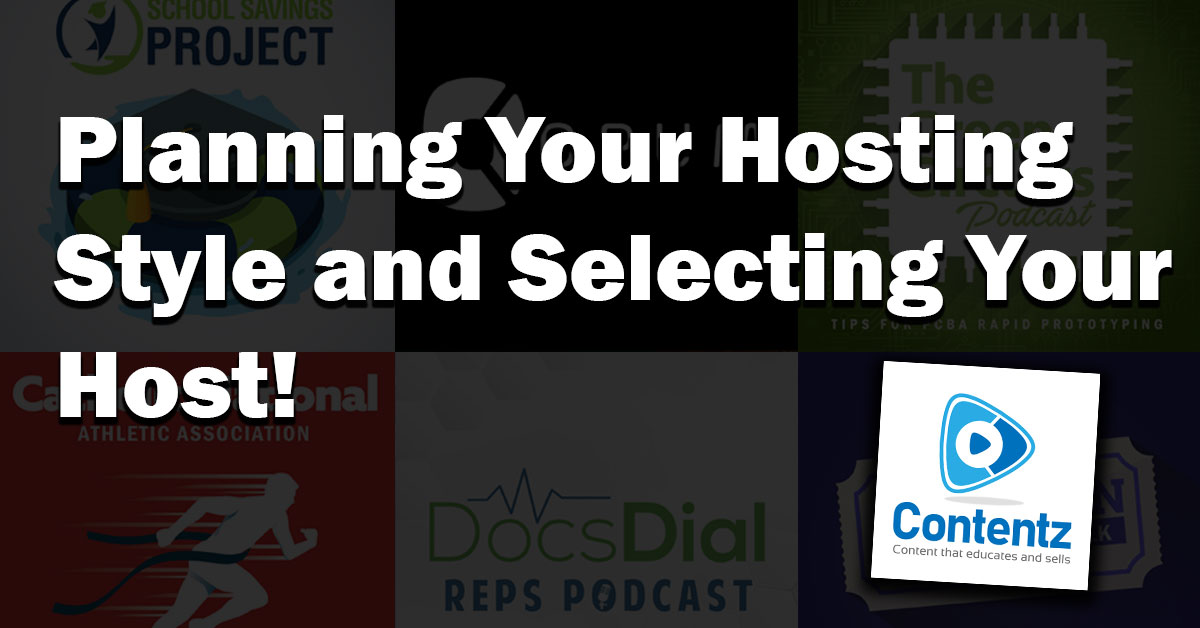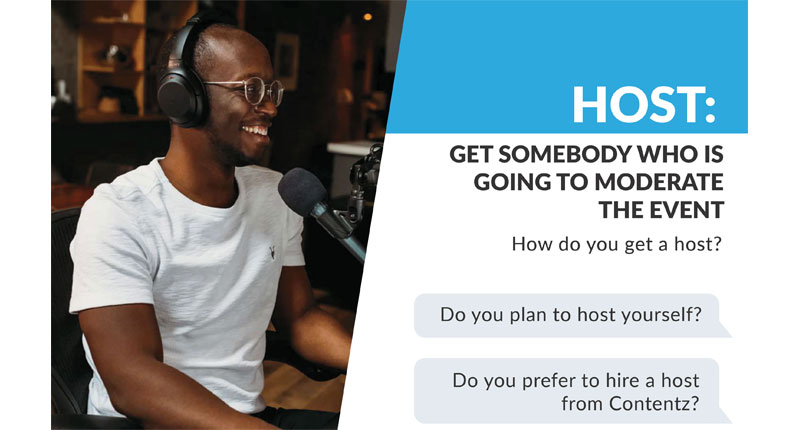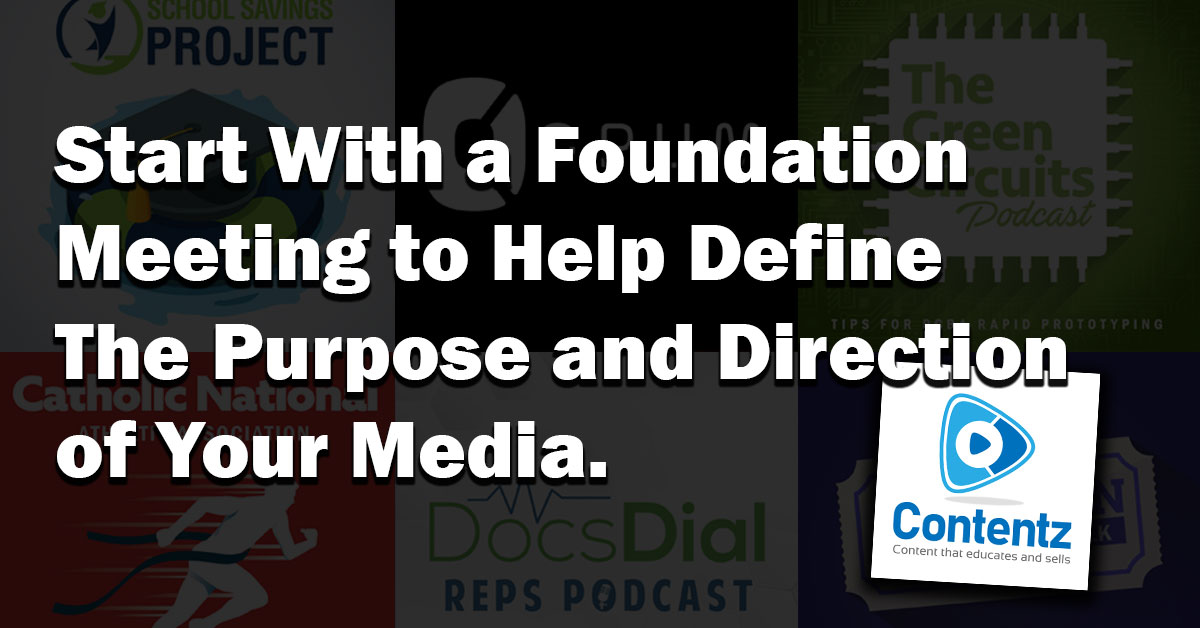Families need money. Businesses needs sales. Sellers need credibility. We provide it all. If you are an early stage startup, pre-seed, bootstrapped, early release, Contentz team is your secret weapon.
How to Sell Sponsorships and Integrate Partners in Podcasts and Video Shows
Sponsorship is an exciting and necessary part of operating a media product, as it brings in revenue and can help with distribution as well.
Sponsorship supports many podcast and video shows as the sole revenue source. Other shows choose not to integrate direct sponsor relationships. This can be the case for businesses relying on YouTube ads and those that are promoting their own services or products within the production.
For companies and organizations that do wish to integrate direct sponsorship, we have developed a brief how-to guide below with resources included that can help you launch a sponsorship campaign.
How to Identify a Potential Sponsor
Potential sponsors are everywhere. Brands need marketing. People watch videos and listen to podcasts. The value sponsors get is being seen by the audience of a show or podcast. Partnering with an existing show to get your brand’s messages out there can be easier and cheaper than developing your own show for some companies. In this way, visualize who would benefit from your show.
Yet, finding the right sponsors for your show can be challenging.
Potential sponsors will have a similar target audience to your target audience. As you build your audience, a sponsor can benefit from this. Other aligned values can also be useful. For example, supporting kids sports leagues with a banner makes a lot of sense for local businesses because it brings them awareness and a positive message. It doesn’t mean that the banner drives customers on a daily basis. But the association and awareness is positive for a business. They share similar target audiences.
Traits of potential sponsorship partner
- Similar target audience as your show
- Actively advertising online
- Common values
How to Position Your Show With Sponsors
Visualize why somebody would want to sponsor your show before heading out to meet with potential sponsors. Granted, you will learn a lot by just getting out there and doing, but you do want to have an idea about what you think will help a sponsor before taking up their time.
What is your value proposition? Most sponsorship works by you promising to deliver an audience and conversion in terms of awareness or actual conversions. You can articulate this in three main ways.
Sell audience
Explain your show in concise terms, with specific demographics that you reach and how the audience interacts with your show. If you have an existing show, analytics can help tell the story. Look at audience demographics, keywords and location. That data is gold for sponsors. If you are planning a new show, then articulate your goals around the target audience and make some mathematically supported assumptions that help tell the story of the audience you’re building. You want to get to a number. You want to be able to speak about your projected audience size and demographics with confidence.
Sell conversions
Explain what conversion that an advertiser can expect from partnering on the show. It can be helpful to plan where you will drive conversion throughout the show. You will also need to be able to track the conversions to back up what you say and to deliver reporting so your sponsor partner can assess progress during the upcoming episodes and campaign you are managing on their behalf. Commonly podcasts and videos introduce advertisers at the beginning, middle and end of their shows. In addition, advertisers often give shows a unique code or landing page to help track conversions based on the sponsor presence in-show.
How to Fulfill Your Sponsorship Creative and Integration
In order to support sponsors, you will need to develop inventory. Shows often can carve out structural positions within the show to announce partners. You can also develop special segments within your show to feature sponsors. It is a delicate balance because you do not want to overwhelm your audience with sponsor messages that can be distracting and take away from your show content. However, a good sponsor will make sure to have a valuable offer for your audience and it should add value overall.
Common Assets in Podcast and Videos
- Opening: the introductory phase of the show creates a logical sponsor placement opportunity.
- Middle: many shows break up their show with an advertising break one or more times through the show.
- End: the end of the show creates another logical sponsor placement opportunity.
- Special Segment: this is a great technique to add sponsor inventory and advance your show. Many shows design a special segment to highlight new or different information and it creates a special opportunity to showcase a sponsor.
- Call Outs: shouting out sponsors can be done tastefully during the course of a show, without interrupting the audience experience.
Fulfillment of Sponsorship
A sponsor partner will expect professional experiences and results as you engage in your business relationship. Fulfillment includes all of the activities and assets that go into delivering the proposed campaign within your show. Fulfillment means doing the work and showing it to your client.
Suggested Process
- Scope Assets: define what the assets in your show will be.
- Mock Assets: create the assets in your show and develop a proof for the client.
- Finalize Assets: after approval, finalize the assets and store them for access
- Integrate with Show Assets: drop in the show assets during your editing process
- Provide Reporting: Measure the results and metrics around the sponsor assets and provide regular reporting to your new sponsorship partner (i.e. client).
- Adapt & Adjust: Make adjustments to the sponsor assets based on reporting and performance.
- Production Meeting: host a regular meeting with clients to review their role in production and results. Weekly may make sense initially. Over time, monthly or quarterly is a good rate depending on the engagement.
Develop Your Outreach Process
Sponsor outreach tends to be a numbers game. Once you identify the traits (i.e. define profile) of sponsors that you feel are a good match for your show, the next step is to reach out to them and offer the space.
Sponsor Outreach Process
- Research: define the profile of your target sponsors.
- Build a list: create a list of at least 100 targets that match your profile traits.
- Create offer: You will want to have an overview of the show which can be developed loosely based on your treatment, along with a rate card (i.e. price list).
- Connect and Follow Up: Call, email, DM. Ask for a meeting and get ready to make your presentation.
- Present: Meet and make your pitch!
Distribution – Promoting Your Show and Content Online On a Budget
Leave no stone unturned – it’s distribution time. That means the work begins after production.
Media Distribution refers to and means methods, by any means, for the publication, transmission, dissemination, distribution and/or delivery of Marketing Media, including podcasts, videos articles, memes and any other content you develop. Simply put, distribution is the process of getting your content viewed by your target audience.
Making great content is useless without your target audience getting the opportunity to watch it or listen to it or read it. Now that you’ve created fantastic content for your target audience, make sure they can see it and interact with it and otherwise love it by distributing the content online, everywhere and every way it could possibly make sense.
There are several techniques to get your media out there. We have outlined 5 methods to get your content seen after release.
Step 1: Publish Direct to Social Profiles
Ideally you have a fanatic social media following just waiting to see what your next post is. So you post your new show to your social profiles on places like LinkedIn, Instagram, Twitter, TikTok, YouTube and Facebook. Your audience sees the content on these platforms and they watch it or read it or listen to it. Simple, right? Well, not everybody has this robust audience in place. Lots of people that produce content are doing so to actually boost their presence and to develop a following on these platforms. Either way, posting on your social media profiles is step one on distribution.
Step 2: Publish to or Get Shares on Other People’s Social Profiles
Do you have partners or supporters? If so, a great way to get your content seen is to request that your friends post a quick note about your new content. This takes some up front planning prior to release of an episode. It is helpful to pre-write a message and design a custom post for a partner. Then, you can reach out with a quick email and DM and say something like: we are releasing this Tuesday. Would you be willing to post this on ‘Twitter’ (for example) to help us promote the show? We would be happy to promote you in the future.’
Even simpler than a custom post promoting your show is a simple share of your post. This is even less work for your partner. It is still helpful to pre-write a message for your community when you ask for help like this. But the process would be 1) post your show 2) message your community and ask for share. A good message is: Hey there, please share and like to help us promote the show. Send me yours when you need help. We would be happy to promote you in the future.’
Partners to Promote With
- Friends
- Partners
- Guests
- News sources
Step 4: Email is a Fantastic Way to Promote Your Media Productions
Email is still king when it comes to engagement and ROI. That means getting your media production out by email to a curated email list is very powerful. Social media is great for easy engagement. Email wins for deeper engagement and frankly there are just more email accounts than social media profiles in the world (i.e. around 8 Billion).
With that said, a great way to get viewers for your show is to email them. Ideally, you have a massive email list and just send it out. If not, you could leverage a partner list and request that they promote your show similar to the social process above. Or, you could have a channel partner that does this as well.
If you do not have an email list, then you should start building one by integrating your website with a newsletter service and mentioning that in your media productions to drive that conversion. There are other ways to build lists fast as well, such as purchasing a list or community outreach and asking for opt-ins. Growing your email list could be an objective or strategy for your show overall.
Step 5: Public Relations Outreach to Promote Your Show
A more formal approach to promoting your show could be warranted if you have the budget and strategy you believe in. Public relations works great with media shows. Write a press release and link the show. Try to identify a relevant story angle that helps your target audience. You can submit a press release broadly by a service like Cision for a couple hundred dollars. This press release will get picked up by several news sources which then gives you more content to share on social media and on your website resulting in more attention and activity online, thus driving viewership. It is not a silver bullet. However, this method can be effective depending on the true impact of your show. Another angle in public relations is reaching out directly to bloggers, who address your target audience.
Step 6: SEO and Long Term Promotions
Slow but sure, the turtle wins the race. Think of SEO as the turtle. This does not happen overnight, but the more you post your media and promote it, the more SEO power your site, brand and social profiles command.
A recommendation is to write an article about your media production episode every time you release. Then, post it to your blog, link the media content and submit the new blog post to Google, Bing and Yahoo at minimum. While results will not come piling in overnight, your efforts will be recognized by search engines and ultimately drive traffic to your properties if you configure keywords and write content correctly.
How to Setup Audio For Your Video or Podcast
There is a saying in podcasting that goes: the way you use the equipment is more important than the equipment itself. In other words, it’s not necessarily about what type of microphone you have, but it is more about how it is positioned and how a speaker addresses it. This is called microphone technique.
We lay out both microphone technique in the Contentz studio, along with the configuration of microphones and software that we offer.
Microphone Technique
There are four main aspects of microphone technique. Mastering these can make your production sound fantastic. They are mic level, proximity, voice level and mic angle.
Mic Level refers to the balance between gain and fade on the mixing board. It controls the quality of audio. If it is not set correctly, the audio will not work at high and low volumes. It makes editing more difficult. The professional recommendation is to adjust the gain knob on your audio interface or mixer until you can hear it buzzing in your headphones, then turn it down slightly.
Proximity refers to the distance between the microphone and guest or host (ie speaker). The closer you are to the microphone, the deeper quality (ie better quality audio) is captured. Quality drops as a speaker gets further away from the microphone. Start with about four finger widths between your mouth and the microphone. Test it and adjust based on what you hear.
Voice level refers to the way somebody speaks into the microphone. If you yell or project more than normal, it can lead to reverb and lousy audio capture. If you naturally speak loudly, then you can adjust mic level and proximity to account for it. If you speak softly, the same applies. The best way to record audio is to speak at a consistent level. Avoid extremes.
Mic angle refers to the direction of the microphone. There are two variations. First is on-axis recording, which positions the microphone as perpendicular to the floor or mounting surface and pointed directly up to the speaker’s mouth. The second variation is off axis, where the microphone is twisted to the side to reach the speaker. On axis results in the brightest recording. Off axis results in less sensitivity to high frequency noises.
Configuration or Microphones
Contentz supports up to four microphones, offering both mounted devices and stand alone microphones. Lapel microphones are also available.
How To Setup Cameras For Your Podcast or Video Show
There are several ways to configure camera setups for show production. Some creativity can go into this area of show development. Positioning cameras can emphasize main points and it can assist with capturing meaningful moments with a guest or host. Cameras can also be used to generate humor in your production, similar to the way ‘The Office’ uses the one-to-one confessional technique where the guest takes the audience out of real time to explain their true feelings.
In person Contentz productions can support up to two cameras in the studio setting and up to 40 on Zoom. Zoom production can be remote, which enables additional characters to connect with their own cameras.
One Camera Setup – camera one in person
A one camera setup captures horizontally oriented footage where both guest and host can be seen at all times. This is a camera in the studio, featuring a shot of both the host and guest. If there is more than one guest, then the camera and guests will be situated where the camera can capture the entire group in one angle. This will match your studio design.
Pros
- Looks ad hoc which can add to the charm of the podcast/video series format
- Does not require additional resources to cut to different shots
- Editing cost is low as a result of only one set of footage needing to be edited
Cons
- Limited options to edit different angles
- No ability to emphasize different points or deliveries by characters. What you see it what you get.
Two Camera setup – horizontal permanent view and cut to camera
Contentz’ in person studio can accommodate up to two cameras. Two cameras can be useful to capture the finer points on a show. If you have an engineer, then two cameras can be used to capture wide angle footage and close up, giving your show flexibility.
Camera one is typically set up as a wide horizontal view capturing all activity, with both guests featured. Camera two is typically set up with an engineer managing cut-to types of moments, which are scripted.
Pros
- Individual cut to: gives ability to edit to more close up or focus on one particular guest
- Medium editing budget: footage can be used to emphasize the point made by an individual
Cons
- Editing budget can be more expensive than a single camera, in particular if you want to have an engineer adjust for close up on camera two. If you do not need zoom-in, then Zoom conference footage can replace two camera footage.
Multi Camera Setup – Zoom Panel (2+ cameras)
Multi camera setup refers to one or two in person cameras mixed with footage on Zoom for guests that are remote and/or more than one guest along with the host.
Multi camera footage is easiest to capture on zoom, in terms of budget and ease of editing. Zoom automatically edits individual close ups in this format. Zoom plus one or two in person cameras can accomplish the effect of wide angle, close up and cut to types of footage. Mixing the three elements of One Camera, two cameras and zoom footage can help get all of the shots you need for your show.
Pros
- Capture more than (1) host and (1) guest. Add up to 50 members and feature their comments in a logical way on video.
- Leverage the in person cameras without having to worry about close ups on face.
Cons
- Editing budget can be high if you want precision mixing up to two in person cameras, along with the Zoom footage.
How to Write a Show Outline
A show outline helps pull together everything you need to produce a specific episode. It will have an overview of the show, information about the guests and topics and specific questions that will be asked during the show.
Think of a show outline as a treatment for the episode specifically, whereas the treatment itself handles the entire series or show as a whole production.
Develop a show outline for each episode that you plan to produce. This document is useful for staff that sets up the studio. It gives them specifics about your needs in the studio and it gives them information about what to prepare for in terms of segments or adjustments to equipment that may be needed. The host will use the show outline to prepare any notes that will be used to enhance the experience for the guest. Guests like to prepare for any questions that will presented as well.
There are five elements to the show outline.
Show Theme:
The show theme is a short paragraph that explains the point of this particular episode in concise terms. Think through the objective of the show and something that gets viewer attention. Don’t use passive language. Try to present the value of the episode in this phrasing. Ultimately this theme phrase can be limited to one sentence at least.
Add any details about the show and points you plan to make under this section.
Guest Background
Collect information for the host to review prior to going live with recording. Most hosts do not want to ad lib the interview entirely. Obviously this will depend on your format but collecting information about the guest’s professional life and work background helps educate the host on the direction of the conversation and it will give them ideas about relevant comments that can be made and questions that can be asked to make a successful, engaging interview.
Easy ways to pull guest information:
- LinkedIn profile
- Company website
- Personal / Organization website
- Social Profiles
Requesting guest background information directly from the guest can be helpful as well. This gives the guest a chance to share what they want you to talk about on the show, versus surprising them with information they are not prepared to communicate about. Again, this will depend on the objective of your show as well as the style, but it is recommended that you consider the guest background prior to hosting for production.
Guest engagement
Guest engagement is extremely important when developing video or audio show. Nothing loses an audience like a guest that is not engaged or comfortable on camera or on a recording.
As an exercise, write out three ways to engage the guest for each interview. Easy examples are professional background questions, personal interest questions, and how the guest got on the show. We have included some examples below. Feel free to use them and customize these questions for your guests.
Professional Background
- How did you get started in this industry?
- What has been the biggest highlight of your experience in this industry?
- What has been the biggest challenge for you in this industry?
- What have you been up to lately at work?
Personal Interest Questions
- I understand you are interested in ‘x.’ How is that going?
- How about those Warriors?
- How about your community? What’s it like living there?
How show episode came to be
- So why are you here today? It’s a great story, tell us about it.
Core Interview
The core interview should start with three segments. You can add more or have less, but for planning purposes, it is always good to have three segments when planning an interview.
As an exercise, list three major topics. List five questions for the guest within the three major topics. Take another look at the questions and reduce them to 3 per section. Then, go ahead and write out any details about the questions that a host could make as statements or a method of qualifying the question.
Next Steps
The beauty of content is that you can provide your audience with something to do and measure the conversion. For example, think of advertising. The ad plays and generally advertisers include a call to action, so the audience can go buy the product or learn more after they watch the ad.
Your production can generate the same results as advertising for you and your guests. Define next steps as they relate to your guest and your production or business for every episode. Perhaps you use the same conversion on every episode. That is fine of course, and it is your choice. But note that guests present different opportunities and you generally want to help your guests with their own objectives. Promote a next step for your guest and outline it in the show outline so your host and production staff can present it with taste and also so it is effective.
How to Attract Audience Prior to Launch
Launching a show gives you a reason to tell the world about what you are working on. Shout it from the rooftops, as they say.
The power of the announcement is major. Consider doing all of the things you have heard about , or perhaps done in the past for your products and services, such as press releases, outreach to partners, marketing to your existing customers and certainly posting all about it on your social profiles.
Try to carve out at least a month, prior to launch so you can get a couple messages out each week about what people can expect. Follow the simple process below.
Process to Launch
- Announce show on social, email, and via partners
- Send reminder about launch via social, email and partners
- Send last chance reminder about launch via social, email and partners
- Send launch message with link to content
- Follow up and say thanks for launch
Creating Launch Messaging for Your Target Audience
Remember the treatment you wrote? Pull the target audience messaging that you created earlier in the process and dust it off.
Build another list (just like you did for guests). Develop another value proposition, just like you did for guests. The only difference is that this exercise is about your target audience (i.e. listeners / watchers).
Design assets – the look and feel of your show
Revisit the show planning position of your show development process. You likely already created a look and feel for your show. Now, use the messaging from the section above to customize those materials and load them into your email, CRM and/or social tools.
To Do List for Launch Messaging
- Draft intro message for email, LinkedIn and Voice
- Build a list of target viewers
- Email, Call, text
- Post on Social Media
- Integrate on your website
- Push messages anywhere that potential viewers spend time
- Request partners to do the same, including the guest speaker.
How To Invite Guests to Join Your Podcast or Show
Guests can impact your show in a major way. A guest can bring awareness to your show, if they have an audience or following. A credible guest can give your show credibility for your target audience. Simultaneously a guest can damage your brand if they are not credible. If you host somebody that has limited knowledge on a topic that you want to present, then your audience will associate that experience with your brand.
You need guests to make things work.. The one caveat would be if you had planned a series that features your host walking through expert content as the sole character in the production.
For this example, let’s assume you want guests on your show. This article is designed to help you plan and reach out to potential guests.
List – decide what type of guests you want on your show
Start by making a list of target guests. Make a list of targets and why they would be good for your show. Look at the list and try to pull out the variables / traits that are common between your example guests. You are looking for a pattern so that you can establish a process to invite guests over time.
For example, we made a list of different stakeholders at Green Circuits, when we launched the Green Circuits podcast. The objective of the show was to showcase talent in the building and create engagement with past customers. We used the show to highlight unique processes and views on the Green Circuits Team. We reached out to team members by email to gauge interest and offered them topics that were relevant to their job responsibilities.
Example Traits:
- Job Title
- Age
- Expertise
- Industry
- Activity on Social media
- Connection Type
Value Proposition – create an explanation about why the guest would want benefit from joining the podcast
Value proposition is defined as a promise of value to be delivered, communicated, and acknowledged. It is mostly used in sales.
Use a value proposition when you approach a guest to join your show. The value proposition will become a big part of your message when you go to invite guests.
Sure – if you know the guest, it is possible that they will join as a favor, without all the formality. However, most shows developed by organizations want to accomplish an objective by producing the show. In order to get the best results, you want to consider value throughout your development so you are able to replicate processes that help the show sustain itself. Ask yourself, how does the show help your guests. Ask yourself, how does the show help watchers or listeners. You don’t want to end up in a situation where if you run out of friends, you don’t have any guests on the show. Alternatively, if you can offer guests value for joining the show, there will be demand for the guest spots.
Questions to consider when writing the value proposition
- What is the topic?
- Who would be interesting to speak with about the topic?
- How does this topic benefit the guest?
- How does joining your show benefit the guest?
Example Value proposition
Join our show and we can help position you as the expert in local real estate, in front of our audience who are marketing experts and may be interested in partnering on a campaign about real estate content.
Outreach – How to Reach Out to Potential Guests and Schedule
Now comes the work. Most connections between show and guests start out with email or social messaging. Reach out to the guests and invite them to your show. Don’t be offended when you get rejected or when there is no response. This piece of the process is a numbers game. It gets easier after the first one. Again, you want to build a process to attract guests with value but you could jump start things with a friend at first. Showing example episodes helps alleviate concerns about your intentions or the production value that can come up when guests consider joining a new show.
Intro Message – drafting, sending and follow up
A guest outreach message should consist of a warm greeting, value proposition, options for timing and next steps and example, if you have one. This allows the target guest to make an educated decision about their interest. Always leave your contact information so the target guest can follow up and clarify if they want. In addition, offering your personal contact information personalizes the process and begins to build rapport.
Elements of a guest outreach message
- Warm greeting
- Ask
- Value proposition
- Link to book
- Link to example
- Personal contact information
Depending on your hosting setup, you could consider having the host send these messages. Bigger shows may have a production assistant that can help with this process. Smaller shows may have the producer / host perform all of this work.
Draft an intro message to invite guests via email, Linkedin, Instagram or voice. We recommend that you adhere to a 3 step process, where you email, call and text every time you perform outreach. This ensures that your target guest has seen your message. We do not recommend over messaging in terms of number of days. A good rule of thumb would be to reach out one time per week. After three weeks, move on to the next guest target.
Send Messages
Send your guest outreach message to 10 target contacts. If you book somebody, that is fantastic. If you do not book anybody, consider adjusting your message and/or reaching your contact list via a different method.
Scheduling & Initial Survey
Allow your target guests to schedule with a service like Calendly. This makes it so the guest can select the best time for their schedule and so there is no back and forth about timing. Secondly, Calendly allows you to collect information about the guest during the booking process and you can automate a lot of the messaging. You can even provide them instructions about how to prepare for the show via automation on Calendly.
Planning Your Host & Style
A good host makes a good show. And at the same time, your host doesn’t have to be the next Oprah Winfrey to make a show work.
But before diving into production, you are going to want to identify who will host and plan some details around their approach, such as tone and style.
Contentz recommends that organizations make sure that they can replicate host talents enough to produce a quality, recurring show that helps you reach your objectives. A worse case scenario would be producing a show and then the host leaves. If this is not planned for, then it would kill the show and likely waste lots of resources that have been invested to that point.
Plan your hosting approach to where the show can go on whether the host is available or not. This takes understanding your approach to the guests and how to engage them.
Types of Hosts
There are three types of hosts that lead shows from the audience perspective. It is important that you choose your host style prior to getting too far in production.
Interviewer
An interviewer style host will guide a show with question asking. They can deliver facts in an opening and closing segment, but they are not relied on for opinion in any way. They prepare a list of questions and tend to be warm enough to get the guest comfortable and to help them start talking but they rarely conflict with a guest. They are a facilitator.
You can find interviewer style hosts online, in your office and at Contentz. The good part about planning your show with an interviewer style host is that you can easily replicate the show, whether they are involved or not. The downside of this host style is that they are not a subject matter expert in the topics that are explored on a show. For example, medical companies often want a subject matter expert to interact with doctors about medical procedures.
Notes on Interview Hosts
- Script consists of questions
- Style is warm and friendly – keeps the conversation going
- Research for these hosts can be easier because it is all new
Scripted
Some shows are planned with an entirely scripted host. This can be an extremely engaging method of hosting; however, it is also very expensive to produce. This host style is very useful for story telling. It also allows for some acting and more relevant sound effects that can also create engagement.
In the case of scripted podcasts, the actual host feels more like a narrator.
A fantastic example of a scripted podcast host is the Business Wars Podcast, where they explore the back stories about how different companies were in competition and even highlight individuals. Business Wars explores rivalries such as Coke and Pepsi, Blockbuster and Netflix and more. Their objective is to grow its audience in order to sell advertising.
Notes on Scripted Host
- Pre-written dialog
- Requires substantial editing
- Can be highly engaging with good writing
Big Personality / Subject Matter Expert
The third host type is categorized as a subject matter expert but you can also think about it like the ‘Big Personality’ host type. This host tends to be very memorable and it is difficult to script or imitate this style. Think of this host as talent. Not every organization that wants to launch a media show will have access to this type of talent.
Big personality or subject matter expert types of hosts generally need to be willing to put their opinions out before the guests. Sometimes this can be awkward between host and guest. In that way, it is important to understand this is a place for conflict. Rush Limbaugh and Sean Hannity of Fox News are great examples of hosts that have big personalities and have created massive followings by putting their personality out on display.
If you are trying to replicate this style, you will need access to somebody who can consistently put their ideas out and defend them. There is a natural conflict in that approach and it makes for great content, but it is also important to understand the formula before diving into this approach.
Subject matter experts can achieve an engaging show without conflict. Jason Walter hosts a real estate market show in Sacramento that does this very well. The host talks through market data and provides high quality analysis. The upside to this approach is that you can definitely position yourself as an expert if you know facts about a valuable topic. The downside is that data and being right can be boring to watch. Be careful about approaching the subject matter expert style without considering these points.
Notes on Big Personality / Subject Matter Experts
- Requires consistent talent
- Requires consistent points of view
- Must be prepared for conflicting points of view from guest
- Can have huge upside if you can replicate
Next Steps
Work with your team to decide which hosting approach will work best to achieve your objectives. Analyze your strengths and weaknesses within your team. What is the best approach to create a replicable, consistent show that drives results for you?
Start With a Foundation Meeting to Define Your Show
A foundation meeting is the best way to get started. Whether you are developing a podcast, zoom panel, article series or video production, start with a foundation meeting.
The learnings from your foundation meeting will ultimately feed into your treatment and show development. A foundation meeting is an important part of your media production.
Once you get your show in the air, up and running smoothly, then you will host production meetings. The foundation meeting is a great way to get it all out in one sitting. Plan on at least one production meeting per week once the show is occurring regularly.
Elements of a foundation meeting
Identify Objective – what do you want your media to result in?
Start by exploring the objective of your media messages. Think through your products and services. How will your audience react in the best case scenario? You will want to craft you show to drive these results. Simultaneously, it is impossible to control the outcome of a media production in every way. Plan to revisit your objective as you see your audience adjust to the media and respond.
Target Audience – who is your media designed to engage?
Define your target audience? Some people say the target audience is obviously our customer base. This can work great. On the other hand, media can be used to help in any area of your business. We have seen clients target their own employees to drive an objective, or partner channels, or the general public. Start with your objective and then move to the target audience. Your content (media production) can help build a relationship and shape views within your target audience. Establish what you want them to do when they hear your show and start following it.
Differentiator – how are you different from the competition?
A differentiator is important in your product and services, just like it is important for your media offerings. What sets you apart from your competition, as you reach to build a relationship with your target audience. Take a look at what other people are doing. Decide whether you like it or not.
Top 3 Sales points – support your differentiator
Clearly list your top 3 sales points that support your differentiator and help propose value. What are they? Write them out. Start to visualize where you can emphasize this with your target audience.
Schedule: episodes and phasing
Consider how many episodes you plan to release, and think about phasing, where you release a set of episodes and then measure results. Plan to release episodes by phases to stay connected with your audience. It may seem great to release an episode every week when you first start. Consider whether that is realistic. Like most aspects of business, you will want to fulfill your promises to your audience just like you want to exceed expectations with customers. Don’t bite off more than you can chew.

